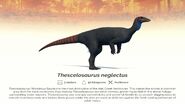"Thescelosaurus (Wondrous Saurian) is the most diminutive of the Hell Creek herbivores. This makes the animal a common prey item for most carnivores, thus making Thescelosaurus secretive animals, preferring to hide in the dense foliage surrounding water sources. Thescelosaurus use strongly curved claws and powerful forelimbs as scratch-digging tools to unearth nutritious roots and tubers. Bony plates under the skin are used as defence against the flank-butting behaviour of adult males."
― Saurian encyclopedia
Thescelosaurus was a genus of small ornithischian dinosaur that appeared at the very end of the Late Cretaceous period in North America. It was a member of the last dinosaurian fauna before the Cretaceous–Paleogene extinction event around 66 million years ago.
Since its discovery, Thescelosaurus has been compared to vaguely similar-looking dinosaurs such as Hypsilophodon of Europe. However, Thescelosaurus lacked an affinity for speed. Its femur (thigh bone) is similar in size to its tibia (shinbone). But in hardcore runners like Hypsilophodon, the latter bone is significantly longer. Also, Thescelosaurus’ toe bones were—unhelpfully—on the short and stubby side. That doesn’t mean it couldn’t be evasive: When necessary, a low center of gravity enabled this animal to make sharp, maneuverable turns.
A 2010 study proposed that, given the types of rocks their fossils are normally found in, Thescelosaurus usually lived around streams and rivers while many other dinosaurs in Hell Creek (like Triceratops) targeted drier land. If Thescelosaurus lived near water browsing upon softer plants growing by the water, then this may have also been an escape route for them when they got attacked. As soon as a predator showed up they may have entered and swum into and across the river, explaining why Thescelosaurus did not retain leg proportions for running, and also how the genus came to be so widespread. Reduced limb proportions would have also helped with locomotion through the water by not being so easy to get tangled in underwater weeds and debris.

Thescelosaurus lifecycle
Thescelosaurus had pointed teeth at the front of the mouth and leaf shaped teeth towards the back. Leaf shaped teeth like these are common in herbivorous dinosaurs that feed upon softer plants as they easily slice through leafy plant material. The pointed teeth are a little more puzzling however, as they are not as well suited to an exclusive diet of plants. This has led some to speculate that Thescelosaurus might have been omnivorous, either eating small animals like lizards or occasionally scavenging carrion. Prominent ridges on the maxilla bones of the skull and the observation that the leaf-shaped maxilla teeth are set well inside the mouth support the idea that Thescelosaurus had quite muscular cheeks to stop food spilling out of the sides of the mouth when processing food. Six pairs of small teeth were also present in the pre-maxilla, though the tip of the premaxilla was toothless to accommodate the horny beak that covered the front of the mouth. This beak would have been the primary shearing apparatus when cropping plants.
The integumentary nature of Thescelosaurus is suggested by a few remains. There are carbonized material patches near the shoulders which have been interpreted as possible epidermis, with a "punctured" texture. It has been proposed that these punctures represented the outings of quills or some filaments, but that's a speculative interpretation. More recently, however, a full leg, pelvic and sacral portion of a Thescelosaurus was preserved with integument in the Tanis fossil site. This fossil is not only relevant for being one of the only dinosaur fossils that shows direct signs of burns from the K-Pg mass extinction asteroid blast, but it also demonstrates that Thescelosaurus had a scaly skin around that portion of the body, contradicting speculative reconstructions where filamentous integument is represented in that body region. Though the discovery is too fresh and its pending further analysis. Additional preserved integument, reported by the discovery of a full mummified specimen, shown with fully scaly skin, was accompanied with the report of the discovery of knobs on the wrists of a few individuals that are believed to be a sexually dimorphic feature, for the individuals that have them have a taller skull than the ones that don't, indicating these might have been used for intraspecific combat.
Predatory threats to Thescelosaurus were many and as adults included the famous tyrannosaur Tyrannosaurus, to the dromaeosaurs, Dakotaraptor and Acheroraptor, the crocodylomorphs Borealosuchus, and for young included the lizard Palaeosaniwa.
In Saurian[]

Juvenile Triceratops and a couple of Thescelosaurus in their natural habitat.
Thescelosaurus is currently present in Saurian. It is portrayed with a mix of feathers and scales. Its' color is black and a red, black and white striped tail to match its' habitat, and a blue throat pouch and a red stripe for display. Currently, Thescelosaurus has no sexual dimorphism or ontogeny.
Dakotaraptor gameplay[]
It's role in the game is to serve as an easy meal for predators, as Thescelosaurus is the smallest herbivorous dinosaur in the game, and it is also not very fast in comparison with other prey items, like the ornithomimids. However, as a juvenile and as a hatchling Dakotaraptor, they should be seen as a wary animal, given that they can kill the player with some ease, while the reverse is more difficult. Closer to the subadult stage, the player starts to manage to kill one with less risks, even though they can be easy to take down by experienced juvenile Dakotaraptor players. Adult Dakotaraptor can still perform RPR on them, as well and they can kill them with ease.
Triceratops gameplay[]
Thescelosaurus are harmless creatures for Triceratops, due to their herbivorous nature. They may be dangerous for young hatchling Triceratops, if you fall in their trampling range, but once you grow to juvenile they are not a threat.



